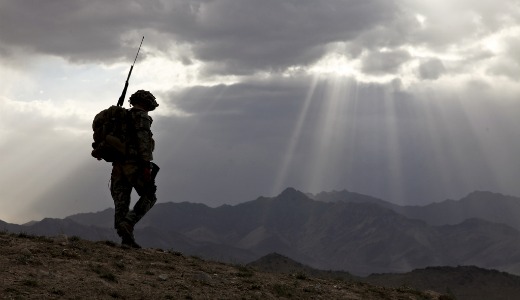
Kabul, Afghanistan – American and allied forces in Afghanistan are strengthening a layered defense along the border with Pakistan to seize Haqqani network militants as they try to make their way to Kabul to carry out spectacular attacks, according to senior military officers – New York Times, August 1, 2011
Okay, New York Times, time for a little geography lesson, with a few bits of history thrown in.
Let’s start with that old Rand McNally three-dimensional map of the world that formerly graced the walls of grammar schools across the country (I happen to have one in my closet). It has low spots to demonstrate deep-sea trenches and bumps for mountain ranges. Among the biggest set of bumps are the Hindu Kush (the western extension of the Himalayas) that corresponds to the border between Afghanistan and Pakistan. The highest of those bumps is Mt. Noshaq (24,580 ft).
This is also a very long border, 1,510 miles more or less (more on that later). Think of the distance between Portland, Maine and Miami, Fla.; New York City and Dallas/Fort Worth or London and Moscow. It is mostly really big bumps, (except some lower ones on the western edge of the border), so it is not only long, it contains some of the most formidable terrain on the planet.
In fact the “official” border is marked from Sikaram Peak to Laman Peak. It is always a bad idea to fight a war where you measure the battlefield by the distance between peaks. If there are general rules of war, certainly one of them is: “Do not fight in places that the Rand McNally three-dimensional map puts lots of bumps.”
This is also not a border, in the normal sense of word, with the striped guardhouses and border checks. For one thing, the Afghans and the Pakistanis had nothing to do with establishing it. That was done-with considerable mischief in mind- in 1893 by Sir Mortimer Durand, then England’s lead colonial officer in India (Pakistan did not yet exist).
His plan was to split up the Pashtuns – an ethnic group who have populated the region since at least the fifth century BC – so that they would not constitute a majority in either region. Pashtuns make up about 42 percent of Afghanistan and about 15 percent of Pakistan. The Pashtuns have never recognized the Durand Line, and neither has the government in Kabul. This makes Pakistan nervous, because aside from India, one of the things Islamabad fears most is ethnic dismemberment: the establishment of an independent Pashtunistan.
Pashtuns on both sides of the border are bound by a common language, culture and kinship system, so independence is hardly out of the question.
Pashtuns are among the most hospitable people in the world, but they don’t like being invaded or occupied, which no one has successfully managed to do, although many have tried. A 19th century British general remarked that when one gets ready to invade the area, the first thing to do is plan a line of retreat, the inevitable course followed by all militaries.
So now, let’s look at “layered defense along the border,” as well as American pressure on the Pakistani military “to cleanse their border of militants.”
First, from the Pashtuns’ point of view, Pakistan’s military is just as much a foreign intruder as were the Greeks, Buddhists, Mongols, Muslims, and British, and Islamabad’s army would have just about the same level of success as all those other invaders. Second, any attempt to “cleanse” the border would stir up major hostilities among the tribes and clans in both countries and feed Pashtun nationalism, which is exactly what Islamabad does not want to do.
But even if Pakistan was to decide to actually try to “cleanse” the border, Islamabad has neither the manpower nor the money to do so (even if it were possible, which history argues it is not). Pakistan has some 1.4 million men under arms, but only a little over 600,000 of those are regular troops. The rest are reserves or border police and local paramilitaries. And most of those troops have to be kept on the border with India, with which Pakistan has fought three wars.
Pakistan’s military is currently engaged both in fighting its own domestic Taliban in South Waziristan and maintaining troops in North Waziristan, but the North West Frontier and Federally Administered Tribal Areas-the part of the world we are talking about-are vast tracts of terrain, and “pacifying” them is quite beyond the capabilities of any army in the world, let alone Pakistan’s.
The situation is not much different on the Afghan side of the border. The combined NATO forces are about 132,000, of which 100,000 are Americans (although 4,000 are headed home in the next few months). However, with the exception of the British, Canadians and Australians, most of the allied troops are not involved in active combat, so the actual number of troops available is closer 110,000. And not all of those troops fight. Some drive trucks, some handle supplies and logistics, some man bases. The final number of fighters? Maybe 60,000.
The Afghan Army is somewhere between 150,000 and 171,000 – the exact number is hard to pin down because so many desert within the first few months – of which only several thousand-two brigades- are capable of fighting on their own. There are also134,000 Afghan police, but they don’t fight. In fact, according to most Afghans, they mostly extort.
You can’t put all those U.S., allied, and Afghan troops on the Pakistan border, particularly since the Taliban have spread their attacks to formally “pacified” areas of the country, in the north, east and west. And. in any case, the Afghan Army is still training (although it is curious that while the Taliban soldiers receive virtually no training, they are able to hold their own in battle with the most sophisticated and well-trained military force in the world).
For arguments sake, let’s say you could put a mix of 40,000 troops on the border, a border of massive mountains and deep valleys, a border filled with passes, trade routes and goat trails, a border that stretches 1,510 miles. With 20,000 troops, the British Army could not seal the 224-mile border between southern and Northern Ireland.
The Taliban are mostly Pashtun, although not all Pashtun are Taliban. Polls indicate that about 12 percent to 15 percent of the Pashtun support the group. But the vast majority of Pashtuns recognize that sooner or later, the Kabul government and the U.S. will have to sit down and make a deal with the Taliban for some kind of coalition government. The lack of support for the insurgents does not mean the Pashtun will betray them. Since the Haqqanis are Pashtun, they can cross this border virtually anyplace, and, as the last few weeks have illustrated, the Taliban and their allies can strike almost anywhere.
The problem with all this nonsense about “thickening the Afghan border” is not the “senior military officials” – generals lie, it’s part of their job description – but that the New York Times would print this blather.
It is not only silly, it feeds dangerous illusions at a time when clear thinking is called for. As Gareth Porter of IPS News reports, “The Taliban leadership is ready to negotiate peace with the United States right now if Washington indicates its willingness to provide a timetable for a complete withdrawal.” According to Porter, the Taliban are willing to break any ties with al-Qaeda and won’t even demand a withdrawal date. The only thing they will insist upon are no U.S. bases.
So why isn’t the Times reporting this breakthrough instead of peddling foolishness?
This column was originally published in Dispatches from the Edge. Photo: U.S. Army // CC 2.0










